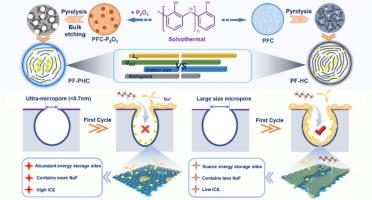增强钠在硬碳中的储存的孔约束和口尺寸的双重调节
IF 14.9
1区 化学
Q1 Energy
引用次数: 0
摘要
硬碳(HC)仍然是钠离子存储的主要阳极候选材料,但其应用受到初始库仑效率(ICE)低和平台容量有限(由于不受控制的缺陷密度和开放孔隙率)的阻碍。在这里,我们提出了一种可扩展的双调节策略,同时调节孔口大小和缺陷化学,以提高钠的储存性能。以酚醛树脂为碳前驱体,以五氧化二磷(P2O5)为双功能牺牲模板和掺杂源,合成了具有高密度封闭孔和亚纳米孔入口的磷功能化硬碳(PF-PHC)。热解过程中P2O5的原位升华促进了闭孔结构的形成,而残余的磷原子有效地钝化了空位型缺陷,从而减少了不可逆的Na+吸附,减轻了过量固体电解质界面相(SEI)的形成。结果,PF-PHC的ICE为89.3%,平台容量为289 mAh g−1。原位表征表明,调节孔口尺寸可以解耦Na+和溶剂进入,实现高选择性离子传输和稳定的界面化学。基于PF-PHC组装的钠离子混合电容器(sihc)具有卓越的倍率性能和出色的长期循环稳定性,在2 A g−1下循环10,000次后仍保持98.2%。这项研究建立了孔口工程作为一个强大的和可扩展的设计原则,以推进下一代基于hc的钠储存材料。本文章由计算机程序翻译,如有差异,请以英文原文为准。

Dual-regulation of pore confinement and mouth size for enhanced sodium storage in hard carbon
Hard carbon (HC) remains a leading anode candidate for sodium-ion storage, yet its application is hindered by low initial Coulombic efficiency (ICE) and limited plateau capacity due to uncontrolled defect density and open porosity. Here, we propose a scalable dual-regulation strategy that simultaneously tunes pore mouth size and defect chemistry to enhance sodium storage performance. Using phenol-formaldehyde resin as the carbon precursor and phosphorus pentoxide (P2O5) as a bifunctional sacrificial template and dopant source, we synthesize phosphorus-functionalized hard carbon (PF-PHC) featuring a high density of closed pores with well-confined sub-nanometer pore entrances. The in-situ sublimation of P2O5 during pyrolysis promotes the formation of closed-pore architectures, while residual phosphorus atoms effectively passivate vacancy-type defects, thereby reducing irreversible Na+ adsorption and mitigating excessive solid electrolyte interphase (SEI) formation. As a result, PF-PHC achieves an ICE of 89.3% and a plateau capacity of 289 mAh g−1. In-situ characterizations reveal that regulating pore mouth dimensions decouples Na+ and solvent access, enabling highly selective ion transport and stable interfacial chemistry. Sodium-ion hybrid capacitors (SIHCs) assembled based on PF-PHC deliver exceptional rate performance and outstanding long-term cycling stability, retaining 98.2% after 10,000 cycles at 2 A g−1. This study establishes pore mouth engineering as a robust and scalable design principle for advancing next-generation HC-based sodium storage materials.
求助全文
通过发布文献求助,成功后即可免费获取论文全文。
去求助
来源期刊

Journal of Energy Chemistry
CHEMISTRY, APPLIED-CHEMISTRY, PHYSICAL
CiteScore
19.10
自引率
8.40%
发文量
3631
审稿时长
15 days
期刊介绍:
The Journal of Energy Chemistry, the official publication of Science Press and the Dalian Institute of Chemical Physics, Chinese Academy of Sciences, serves as a platform for reporting creative research and innovative applications in energy chemistry. It mainly reports on creative researches and innovative applications of chemical conversions of fossil energy, carbon dioxide, electrochemical energy and hydrogen energy, as well as the conversions of biomass and solar energy related with chemical issues to promote academic exchanges in the field of energy chemistry and to accelerate the exploration, research and development of energy science and technologies.
This journal focuses on original research papers covering various topics within energy chemistry worldwide, including:
Optimized utilization of fossil energy
Hydrogen energy
Conversion and storage of electrochemical energy
Capture, storage, and chemical conversion of carbon dioxide
Materials and nanotechnologies for energy conversion and storage
Chemistry in biomass conversion
Chemistry in the utilization of solar energy
 求助内容:
求助内容: 应助结果提醒方式:
应助结果提醒方式:


